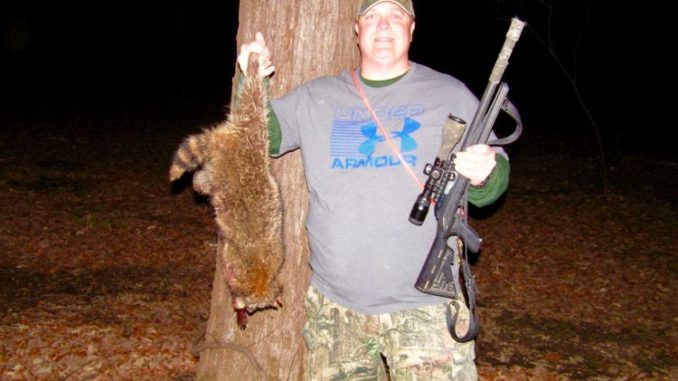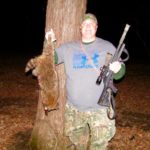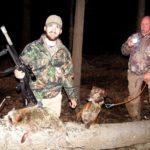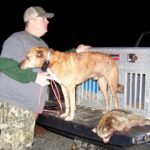
Or at least barking dogs, spotlights, gunfire — and an angry raccoon up a tree — make it seem that way.
The late Jerry Clower may be the only person that coon hunting ever made famous, or vice versa. The “Mouth of Mississippi” won a bushel of country comedy awards and never recorded an album or put on a performance without telling a good coon hunting story.
Today in Louisiana, we definitely have more glamorous outdoor opportunities than Clower did in his youth. But there are still some people who would just as soon be in the winter woods, tromping through hardwood bottoms with a flashlight and waiting for the dogs to bay at a treed raccoon. That, in a nutshell, is what coon hunting is.
One of those people is Chris Jones of West Monroe. Jones is a former coach, a school administrator and family man who stays busy day and night going from one activity to another. And that is one reason he likes to coon hunt. It’s his “pause button.”
“There’s no pressure in coon hunting,” Jones said. “It’s a chance to get away from everything and it’s at night, so all your senses are in play out there. And it’s a sport where you can enjoy the people you are with, and even more importantly, a sport where you can take your kids or other kids and have a good time.”
The thrill of the hunt
Jones described a typical hunt with coon-hunting friends Blaine Armstrong and Phil Flurry.
“We meet up right at dark, have our Ranger ATVs ready if we are going to cover a lot of ground, put on our tall boots and head for the woods,” Jones said. “I’m blessed to know a bunch of people who have land where we can coon hunt. There are public areas like the D’Arbonne National Wildlife Refuge and Tenses National Wildlife Refuge that have lots of great places to hunt raccoons.
“We go out at a leisurely pace, let the dogs loose and then just tell jokes and stories and listen to the dogs bark. When they get on a coon trail or get one treed, you can hear it in the way they are barking. That’s when we head for where they are. They can be 100 yards away or a mile away.”
Jones says once the dogs get a coon treed, they get there as fast as they can because the coons will climb out on a limb and get in another tree if they take too long. The hunters don’t like that — and neither do the dogs.
Jones grinned when he told about why coon hunting these days can be so laid back. It’s actually much easier than ever before.
“When I got started about 10 years ago, you kept up with the dogs a lot better because you didn’t want to lose them,” he said. “Today we have collars on the dogs and hand held GPS locators that pinpoint not only exactly where the dog is, but which direction he’s heading and if he’s running, sitting or starting to circle. When he starts to tighten up that circle, you know he’s about to tree.”
Jones and his hunting partners watch all that action and information on the small GPS screen standing there in the dark of night. Hunters can also see roads, levees, bayous and creeks, fields and other landmarks on the GPS screen, so that makes it easier to get in and out of areas where the dogs are working.
A good dog is a hunter’s best friend
There’s another reason the GPS units are handy: The cost of a modern-day coon dog can range from $3,000, to $25,000 or more.
“When you turn them lose, that’s a big investment you are putting out there in the woods in the dark,” Jones said. “You want to know where he is.”
There is no set pattern for locating good coon hunting woods, but Jones said most good territory is bottomland hardwood with a water source not too far away.
If you are hunting in deer club woods right after the season, areas near feeders also attract raccoons. Jones does not hunt coons during the active deer hunting seasons to avoid conflicts with the hunters.
Obviously the key element in coon hunting is one or more good coon dogs. Jones explained how to get a good one, like his Original Mountain Cur, Tiger.
“You need to get a dog that has come from a good line of treeing dogs,” Jones said. “There’s two ways to do that. You can get one as a puppy and take him to the woods as a puppy and grow him into a dog. Or you can get a mature dog, and as one of my friends says, that is kind of like buying a lottery ticket — you take him to the woods, scratch it off and see what you’ve got.
“Either way, most of being a good tree dog is bred into them naturally. When I started Tiger off as a pup, I showed him a couple of raccoons in a cage and let him get the smell. The first couple of times we went, he didn’t do much. But then one night he was treeing coons left and right. It was like a light bulb had gone off. Once they learn what they are supposed to do and that you are going to come and shoot, they just get better and better.”
War stories
And just like Clower, Jones and his coon hunting companions have lots of stories. Some are harrowing, like when the dogs bayed a big feral hog and the hunters came up on it 20 yards away armed with nothing but headlamps and one little .22 rifle. On occasion, they’ll hear strange noises in the night that are unexplainable. When that happens, they just brush it off and move on.
One Clower-like story that Jones likes to tell involved Tiger and Phillip’s dog, Blue Duck. They are used to hunting together, but one night when they shot a coon out of the tree, it wasn’t dead. So Blue Duck ran up and grabbed the coon on its chest. The coon proceeded to bite down on Blue Duck’s big coon dog ear. About the time Blue Duck let go, Tiger grabbed hold of the coon’s backside. So the coon didn’t let go.
The three of them ran around in a circle for several minutes before the frantic hunters got them separated. The sounds from that ruckus in the middle of the night likely would have scared off the bravest person within hearing distance. By the time they ended the battle, old Blue Duck’s ear was in such bad shape they had to pack it in and go home.
But all ended well — and they were back in the woods in a week. As Jones would say, taking off on a fishing saying, “A bad night coon hunting is still better than a good day at work.”





